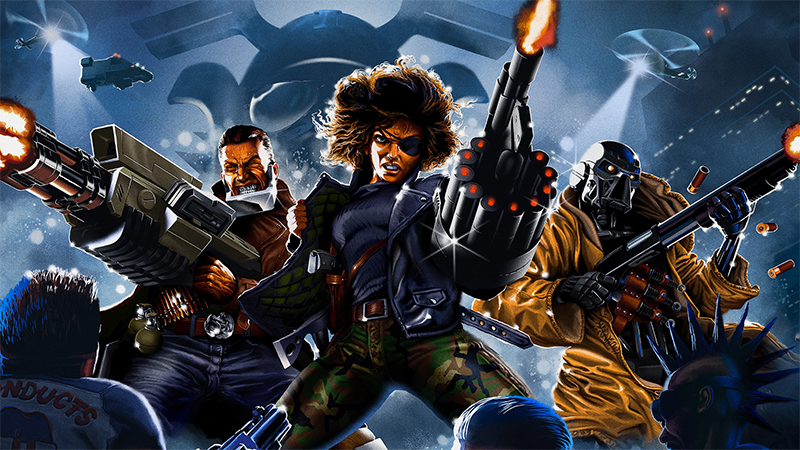It’s incredibly difficult to separate the good retro homages from the mediocre or bad ones since there are so many. Contra-style games have always been a popular touchpoint for indie developers, as shown by titles like Cuphead, Blazing Chrome, Mercenary Kings, and Valfaris to name a few. Huntdown is yet another one of these types of side-scrolling shooters and the intentionally ridiculous characters on its cover and its pixelated art style mean that it can very easily be one of those games that struggles to rise above its obvious influences. However, it is so much more than the homage it appears to be.
Being a Contra-like run-and-gun game means that Konami series serves as an effective shorthand for its general flow. In Huntdown, players move from left to right, shooting copious amounts of bad dudes with a variety of explosive weaponry. It’s a basic and apt explanation, but this game excels in the details that make up those systems.
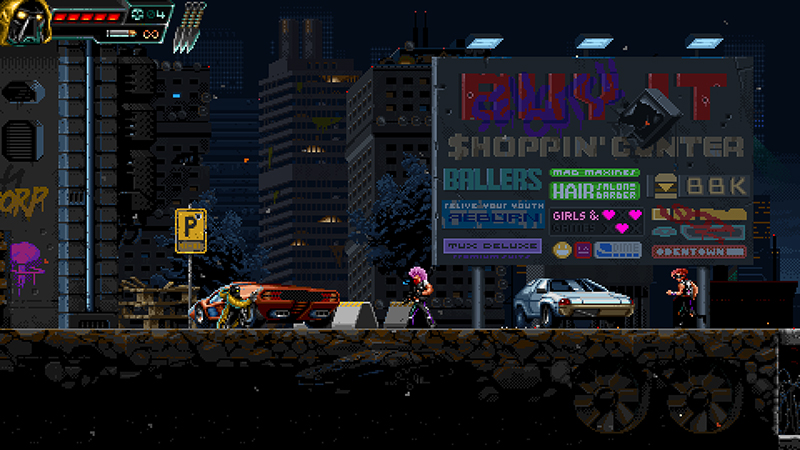
Huntdown’s controls are the biggest and most noticeable improvement, as they give players more freedom of movement and push the genre forward. Its dash ability makes projectiles easier to dodge and even functions as a sort of Smash Bros.-esque wavedash in the air, since its diagonal trajectory yields some forward momentum. This works in tandem with the slide that can smoothly glide under projectiles during a sprint. There are also recesses to hide in and bits of cover that help protect players from bullets for those times where less aggressive defensive actions are more appropriate.
All of these moves make Huntdown a more skill-dependent game that goes beyond pattern recognition and simply jumping over bullets. Being able to dodge through shots is smooth since there are just enough invulnerability frames to make it an effective tool, but not too many to where it can be abused or mistimed, something that is also reinforced through its somewhat lengthy cooldown. Sliding also keeps up momentum and means players can quickly react to incoming fire without breaking their stride. Taking cover does take a second too long and can lead to some unexpected hits, but is generally a solid addition since it is yet another option to utilize, and something that further deepens Huntdown‘s gameplay and makes it a joy to play.
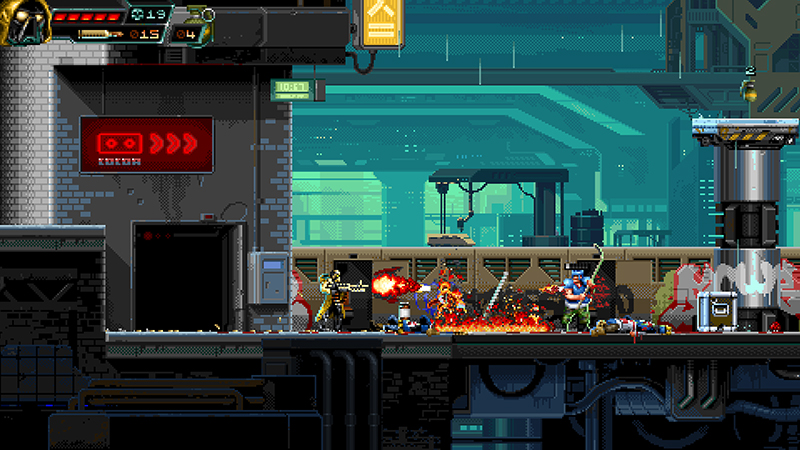
The thoughtfulness that Easy Trigger Games applied to the core move set extends to the other parts of the game, too, and the difficulty is one of the best examples of the studio’s creative touch. By default, the game is not as punishingly designed as those that came before it. Checkpoints are plentiful and mean that dying is nothing more than a temporary setback and learning experience.
But these gestures don’t mean Huntdown is a cakewalk. The default mode is almost flawlessly tuned, as it starts out with simple enemies to give players time to acclimate before gradually ramping up with each passing stage. Later sections can become a warzone of flying bullets and rampant explosions, but its natural progression means players aren’t ill-equipped to deal with these chaotic fights. Its many intricate and well-designed multi-stage boss fights are microcosms of this philosophy, since they all push users to recognize their patterns and adapt to them before being good enough to land the climactic killing blow. Death always comes with a lesson and, except for one boss fight, is never frustrating, thanks to the tuning as well as the aforementioned impeccably fluid controls.
Easy Trigger’s expertise with difficulty extends to the extreme ends of the spectrum. The easiest mode provides more item drops, so even those that find its fair default setting to be too much can still make progress. And masochists yearning for an old school challenge can dive into its Arcade mode that gives players only a few lives per world or its two harder difficulties that cut the player’s hit points. Normal is tuned phenomenally well for most people, but giving hardened, nostalgic players multiple ways to push themselves while not forsaking newcomers demonstrates how thorough Huntdown’s design is. Many love the challenge inherent to games like this, but some only find it to be an insurmountable obstacle and the best contemporary throwbacks succeed by keeping all types of players in mind.
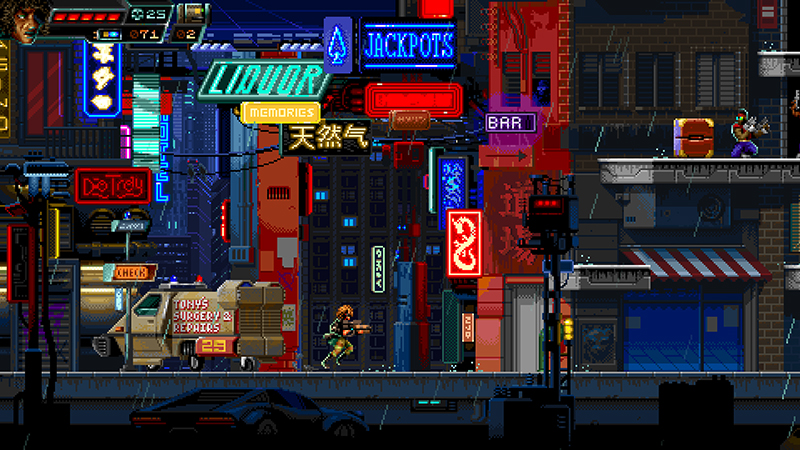
It’s hard to appreciate these gameplay nuances at a glance since the overuse of pixel art has made it easy to gloss over almost any game that uses said style. But Huntdown utilizes this oft-used aesthetic well by injecting tons of personality into key areas. Backgrounds contain sprawling vistas of its broken world that take inspiration from films like Blade Runner, Escape from New York, RoboCop, and more with their juxtaposition of bright neon lighting up a dour dystopia. It’s not a new combination, but the quality of its art and color palette carry it well past the cliché a lesser game would be.
The foregrounds are more impressive, as they are densely populated with all sorts of trash and set dressing that appropriately conveys the theme of the world in hand. Said themes complement the stellar art since they all have unique executions of tried concepts.
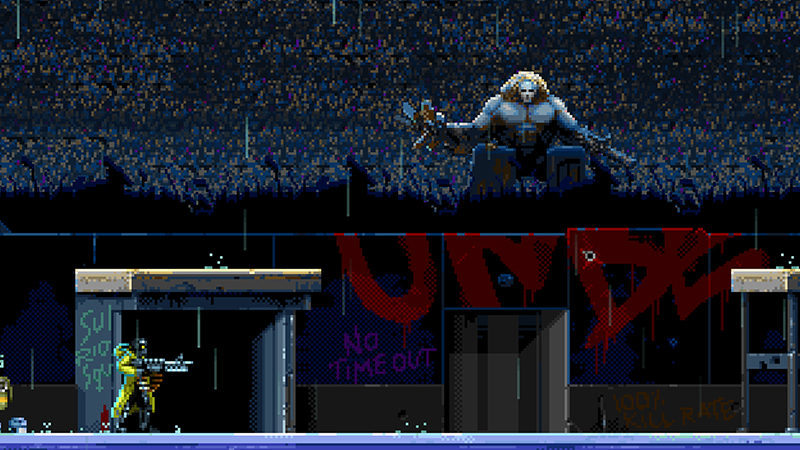
There’s a Mad Max-like vehicular group that mashes 1950s greaser subculture with futuristic junkyards. The final level mixes blaxploitation and martial arts movies from the era, resulting in a collection of levels with a hybrid of urban and Asian-inspired architecture. The second world is unquestionably the strongest of the bunch, as it merges The Warriors with a Mighty Ducks-like gang of hockey players that are amazingly named The Misconducts. This one-of-a-kind band of criminals is led by someone who also has a similarly clever name: Unholy Goalie. All 20 of the bosses all have their own personality that’s not just a collection of iconic movie lines and are brought to life by the appropriately over-the-top performances. Players only interact with these cheeseball villains for a few minutes, but they’re memorable because of their silly names and clever designs.
Huntdown succeeds because of its personality, but it’s not just a clever mishmash of the media that came before it. Its responsive controls are deep enough to give players more freedom over their movement, which result in a snappier and more modern game. Difficulty is also immaculately tuned on the base setting, yet it also has modes for those who want a forgiving experience or one that calls back to the unforgiving, quarter-eating days of the arcade. Its soundtrack of mostly forgettable tunes is sadly the only part of the experience that doesn’t strike the same elegant balance between new and old that the rest of the game achieves wonderfully. It’s an otherwise fantastic balance that makes Huntdown more than a collage of references designed to prey on nostalgia, and one of the better and expertly crafted entries in the crowded retro run-and-gun genre.
